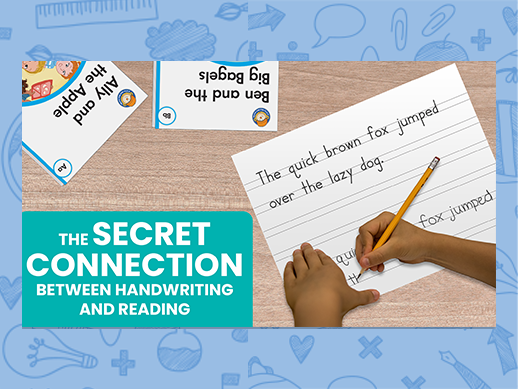
Professor of Language and Literacy
Utah State University
A major priority for early grade teachers is how to best develop students as readers and writers. Becoming literate entails numerous subskills that take time to develop and benefit from consolidated instruction. Teachers may not generally think of themselves as consolidators, but perhaps they should. Early reading instruction is a good example of how consolidating skills could save time while better preparing students.
In psychology, the concept of consolidation refers to neurobiological processes that support the making of a permanent memory following a learning activity. This definition describes the human capacity to strengthen learning via sufficient and multisensory exposure. When learning is consolidated from repeated firing of related neurons, the learning pathways are stronger and more readily accessed.
Early literacy instruction is intended to help children become fluent readers and writers. Through repetition, basic skills become automatic, which allows available cognitive resources to attend to other aspects—including focusing on meaning, what comes next, or how to handle a problem. Whether in reading, writing, or riding a bike, automaticity means that sub skills, such as letter-sound matching, how to form a letter, or slowing down to make a turn, have become consolidated.
One way to consolidate basic skills is to teach handwriting along with early reading instruction. This can be done by teaching the name of a letter and its associated sound, along with the shape or features of the letter. Practicing the name, sound, and shape together reinforces letter learning utilizing a multimodal, multisensory approach. Students are seeing, saying, hearing, and physically forming letters on a surface. Discussing the shape of letters and guiding children to imitate the start and sequence of letter strokes incorporates visual and kinesthetic modes to learning letter names and their sounds.
 Learn more by attending our FREE webinar:
Learn more by attending our FREE webinar:
The Secret Connection Between Handwriting and Reading
Simply put, adding handwriting practice to phonics instruction strengthens the synapses associated with letter learning for more automatic retrieval.
Reinforcing Skills with Handwriting
The research supporting handwriting instruction is mounting—even when some may think that technology could make handwriting obsolete. Approximately 30-40% of students demonstrate writing difficulties. Together, reading and writing delays account for the majority of referrals to special educational services. In both cases, struggling students are not likely to catch up with their peers without solid instruction. Furthermore, learners who struggle with handwriting also typically struggle with keyboarding.
Learning Without Tears® believes that both handwriting and keyboarding are important skills that all children must learn to be effective and efficient communicators. Like the Handwriting Without Tears® curriculum, Keyboarding Without Tears® is taught in a developmental sequence and reinforces important literacy skills. As children learn important digital-citizen skills and how to keyboard with proper finger placement and strokes, children are exposed to a variety of texts. No matter whether children are writing or keyboarding, they must be able to identify letter names, sounds, and forms.
How Handwriting and Phonics Work Together
There are several reasons to teach handwriting along with early phonics instruction. Knowing the letter names and being able to write them quickly are highly correlated—they go together and contribute to a more consolidated awareness of the written code. Handwriting fluency is also correlated with general academic achievement. Poor hand-writers are not likely to develop as productive writers because their struggles to form letters interfere with getting their ideas down on paper.
Using Handwriting Without Tears curriculum materials helps students develop automaticity when forming letters so that they have more cognitive capacity for developing their thoughts, ideas, and opinions—instead of focusing on how to form letters. Here are examples of a first-grade student’s handwriting from the beginning and end of the school year after just 10–15 minutes a day of Handwriting Without Tears. Not only does the student’s handwriting and letter formation improve, but they are able to write more creatively about what they think.
Teaching handwriting with phonics is also efficient. Handwriting practice can easily be incorporated into phonics lessons as the letters are introduced. Practicing a few letters, perhaps those that share similarities, conforms to the recommendation for blocked practice—writing a letter several times.
The Handwriting Without Tears developmental approach groups letters with similar starting places and strokes. For example, the first set of capital letters that students learn are called Frog Jump Letters (letters F E D P B R N M are all formed with a big line down, frog jump to the top, and then the rest of the strokes are added moving left-to-right to complete the letter).
Not only does this support students in proper formation, but it also prevents students from reversing letters. This repeated practice of a few related items allows rehearsal of the names, sounds, and shapes. Tracing letter shapes, writing them in the air, on a palm, or partner’s back takes only seconds during a phonics lesson. Teachers and students can restate the letter name while rehearsing a letter’s strokes (e.g., The lowercase letter d is a “magic c” letter. It starts with a magic c letter. It starts with a magic c, goes up like a helicopter, up higher, comes back down and bumps the line). This language can be easily incorporated not only during handwriting instruction but also during social studies, science, or any subject throughout the day. Practicing selected letters in sand, shaving cream, cornstarch (with a little water and food coloring) at a writing station are also child-friendly options.
When using A–Z for Mat Man® and Me or Phonics, Reading, and Me™, students have many opportunities to practice their alphabet knowledge and phonics skills at a variety of centers.
Writing Engages the Reading Brain
Building letter-feature awareness appears to activate what is called the reading network—areas in the brain associated with reading. This means that writing letters engages the reading brain.
One activity that can motivate young students includes using letters or letter components to form letters and words. By giving students letter cut-outs and a rectangular card, teachers can describe a letter and challenge students to identify and put it on the card. Teachers can dictate words for students to sequence on a card using cut out letters, supporting spatial orientation before students write on lined papers, while at the same time reinforcing the associated phonemes to support phonemic awareness and decoding. One of the multimodal phonics activities in Phonics, Reading, and Me challenges students to build words with letter tiles and write the words on double-lined paper.
Letter writing and spelling constitute the transcribing tools that enable writers to communicate more efficiently. Handwriting instruction that results in letter-writing fluency also supports orthographic awareness—understanding the ways words work. Making and writing words contribute to spelling, which allows writers to communicate ideas more easily and makes school more satisfying. Our HWT materials and Building Writers supports children in developing orthographic awareness. Students are not just taught to form letters but are taught to understand that letters have a corresponding sound and that those letters and sounds together make words and that words together coherently express a thought, opinion, or idea.
Early literacy instruction can be fun but should be intentional—engaging students with developmentally appropriate activities that promote a strong foundation of language cognitively and physically. As we have explored, handwriting instruction promotes neuromuscular consolidation. Neural pathways are activated supporting cognition while fine motor skills are developed for writing efficiency. Integrating handwriting into foundational literacy instruction enables young learners to consolidate these skills for future success. Learning Without Tears offers educators, OTs, and families a developmental teaching approach and practical strategies to ensure that students achieve reading and writing success.
Teachers are busy professionals. They are expected to provide effective instruction by delivering a solid curriculum to students with a variety of learning needs. Being effective and efficient teachers includes making many decisions—about what to teach, how to teach, for how long, and how to adapt instruction to meet the needs of all learners. Teaching is incredibly complex work!
A History of Systematic, Effective Instruction
Learning Without Tears provides effective programs, strategies and tools that support teachers in making learning effective and fun. For over 40 years, Learning Without Tears has provided curriculum, learning materials and strategies that are developmentally appropriate, multimodal, and multisensory. Handwriting Without Tears helps students identify, build, and write capital and lowercase letters with very simple language and hands-on materials. Our letter formation charts have simple language that students use as they build letters with wood pieces, form letters with dough or sing and air-write letters to music.
Handwriting Without Tears is structured to help children learn letters in a systematic and explicit manner with familiar starts and strokes. Before paper practice, children are given multiple opportunities to practice how to form and place letters on lines with multisensory activities like the Magnetic Blackboard and Lowercase Set.
Materials like these complement and reinforce the phonics and word study skills in our alphabet knowledge and phonics programs—A–Z for Mat Man and Me and Phonics, Reading, and Me. These programs use Handwriting Without Tears’ instructional language and methods throughout. Children can practice phonics and word study skills right away in these programs by reading connected texts and writing in their Practice Book or Reading Response Journal using the strategies from Handwriting Without Tears.
About the Author
Dr. Kathleen (Kit) Mohr is a Professor of Language and Literacy at Utah State University, where she directs the Ph.D. in Education program. Dr. Mohr developed an interest in language and literacy development while teaching at elementary schools in Texas and California. She has written and contributed to numerous scholarly publications and is currently focusing her teaching at the graduate level and researching how to accelerate language and literacy development in young children.